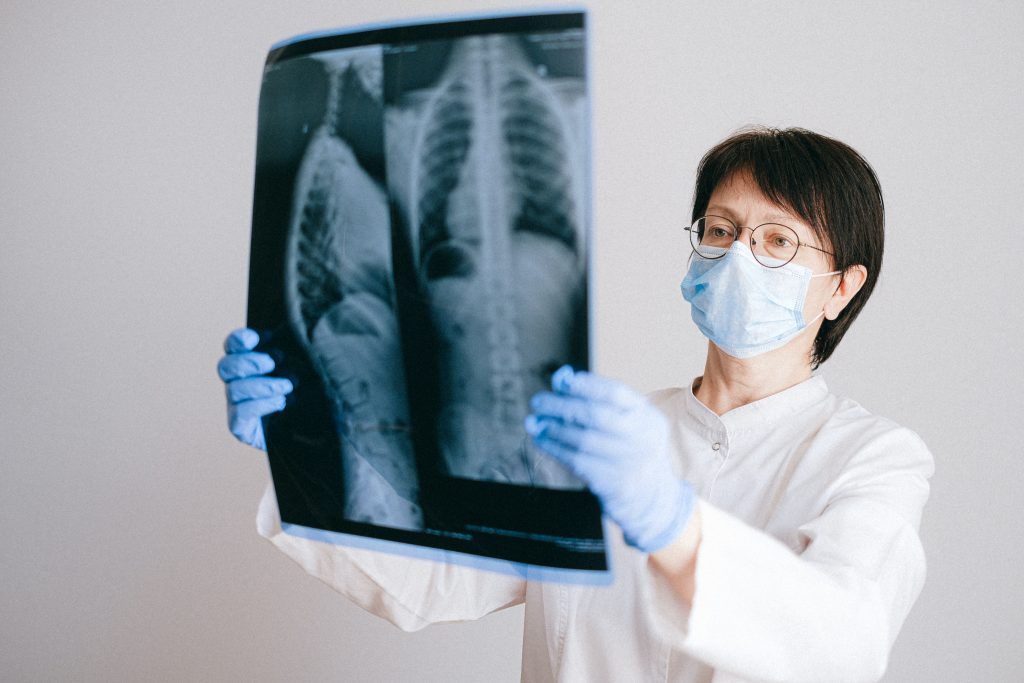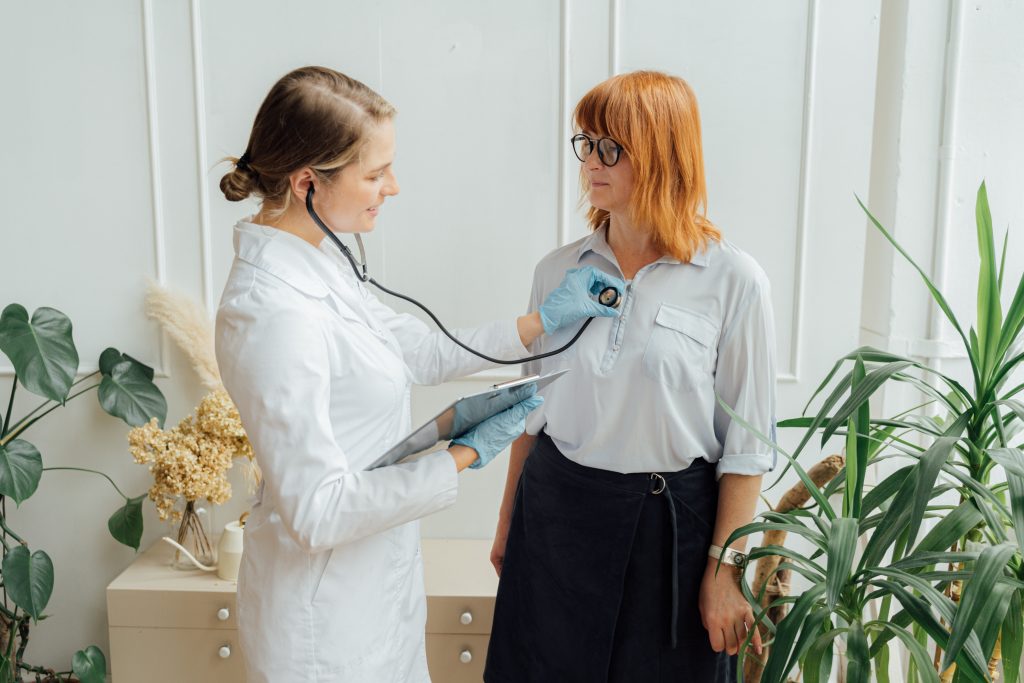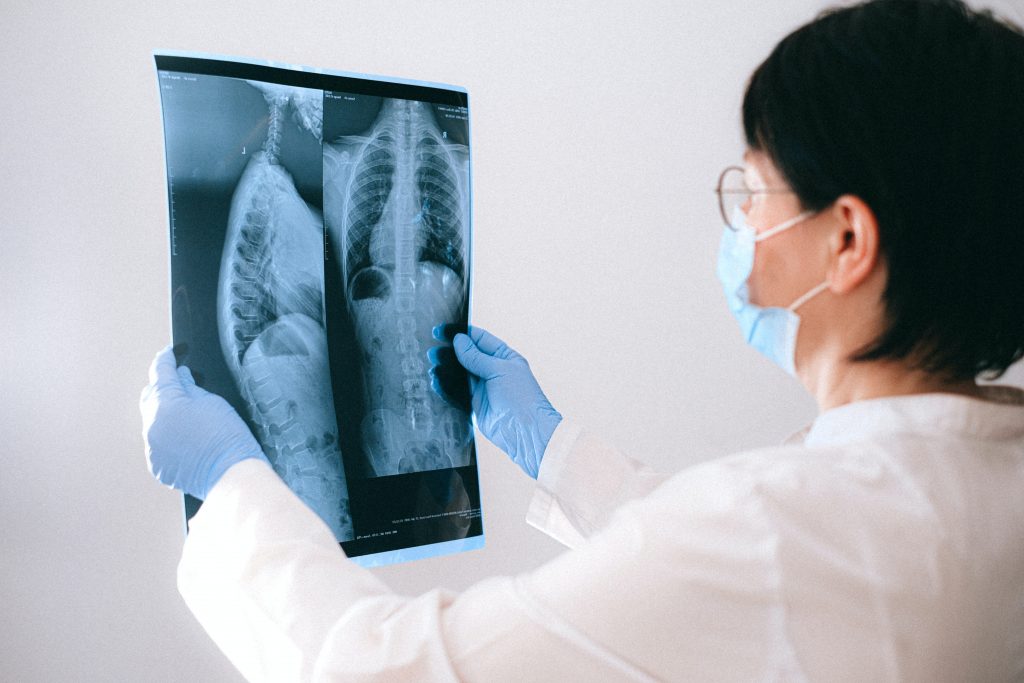Respiratory & chest xrays

Cardio-respiratory physiotherapy
The physiotherapist can obtain information from lung sounds and CXR presentation about disease progression, baselines within assessment and treatment effectiveness. Clinical reasoning based upon knowledge of pathology and disease progression in the cardio-respiratory patient is essential for effective treatment management. The information gathered is used in conjunction with other patient related information (e.g. past medical history, social history, knowledge of previous treatment) and the physiotherapists knowledge of patho-physiology to establish a problem list. Evidence based treatment plans generated for particular pathologies will be influenced by the severity and progress of a condition. Some stages of disease maybe indicators for specific treatments, such as the retained fluid seen on CXR in pulmonary oedema patients indicating the need for active cycle breathing techniques to help clear airways. Likewise some conditions will contraindicate certain methods of treatment, e.g. in the asthma patient who is experiencing bronchospasm it would be unwise to percuss the chest wall as this is likely to provoke further bronchospasm and thus regress the patients capacity to ventilate.
According to Pryor and Prasad (2002) the turbulent air moving through the lungs can be heard when the diaphragm of a stethoscope is placed upon the chest wall, this action is termed auscultation and is widely used in cardio respiratory physiotherapy as an assessment tool. Kisner and Colby (2002) explain that vesicular sounds (normal breath sounds) are heard on inspiration over most of the chest and are soft, low pitched, breezy and faint. Bronchial sounds are the bronchi exhibiting a loud, hollow or tubular high pitch sound.
A skilled physiotherapist can identify diminished sounds characterised by low air flow turbulence caused by airway obstruction (emphysema, hyperinflation, tumour, sputum plugs) or fluid in the pleural space blocking sound (Pryor and Prasad 2002). Wheezes can be heard in lungs where a single airway (monophonic) or multitude of airways (polyphonic) are obstructed due to compression or narrowing, causing airflow to resonate the airways, this is common in bronchospasm found in asthma. Crackles or crepitations are the sound alveoli make when they snap open during ventilation. During assessment it is important for the physiotherapist to identify at what time during inspiration these crackles or added sounds are heard (early or late), where they are heard (localised or widespread) and what type of crackle is made (fine or coarse) as this information can be used by the physiotherapist with other sources (CXR, diagnosis, medical history etc) to identify pathology, develop a problem list and indicate if a treatment is effective.
Auscultations


Asthma
Hillegass and Sadowsky (2001, p266-9) define asthma as a chronic inflammatory disease of the airways which affects the tracheobronchial tree sensitivity to allergens and pollutants which cause constriction of the bronchial smooth muscles, reduced cillary activity and increased mucus secretion. Auscultations may reveal crackles on inspiration as alveoli snap open when filling with air and a wheeze as the air turbulently navigates its way through constricted and obstructed airways. Such a presentation would indicate to the physiotherapist that the patient is suffering from reduced lung volumes with retained secretions and an increased work of breathing. If not all of the airways are narrowed then the patient may well have the ability to expectorate some retained secretions and thus active cycle of breathing is indicated. Active cycle of breathing technique (ACBT) using forced expiratory techniques (huffs and coughs), thoracic expansion exercises (deep breathing with 3 second inspiratory hold to incorporate collateral ventilation) with relaxed breathing have been shown to be effective in clearing bronchial secretions and increasing lung volumes (Pryor and Prasad, 2002).
If the secretions were not mobilising using ACBT, then humidified air via Hudson mask or saline nebulisers are indicated to moisten the airways so the sputum has a less adhesive surface to stick to. The moisture also provides the cillia with a preferred working environment (fluid blanket) so the bodies own secretion removal system will benefit (cillary action).
A CXR common to asthma suffers has a flattened diaphragm and hyperinflated chest or barrel chest indicating to the physiotherapist that air is not able to leave the lung, thus increasing the pressure within the chest. Here the use of Continuous positive airways pressure (CPAP) is indicated. CPAP splints open collapsing alveoli and bronchioles by raising the positive expiratory end pressure, resulting in better V/Q matching and less air being trapped in the distal airways.
According to Hillegass and Sadowsky (2001) when looking at a severe acute asthma suffer one may see evidence of fatigue, shortness of breath (dyspnoea) and distress. The physiotherapists may chose to position the patient comfortably (supported sitting or side lying) and attempt to calm them before further assessment. Should the patient experience increased work of breathing as airways are becoming constricted and obstructed it signifies to the physiotherapist that relaxation techniques to bring the patients respiratory rate under control would be an effective start to treatment.
According to Pryor and Prasad (2002) postural drainage or gravity assisted positioning is a useful method to improve V/Q matching and help mobilise retained secretions formed by increased mucus production. Chest percussion or vibrations can be used with breathing exercises and postural drainage to dislodge and encourage the movement of secretions in a particular region of the lung, however evidence suggests this could also cause further bronchospasm in patients with chronic lung disease (Pryor and Prasad 2002, p431, Campbell, O’Connell and Wilson 1975, Wollmer, Ursing, Midgren and Eriksson 1985) hence is contraindicated for the sensitive asthma suffer.
The management of asthma by using bronchodilators via inhalers or nebulisers, relaxed breathing techniques and positioning (sitting or standing), is common for chronic suffers with increased work of breathing. During severe acute episodes where problems are retained sputum, reduced lung volumes or hyperinflation and increased work of breathing due to bronchospasm more intensive management is necessary. Salbutamol nebulisers are effective bronchodilators and the physiotherapist may decide to check the patient’s charts in order to time their treatment to occur just after a dose as the airways will be at maximal dilation, thus allowing air entry and secretion expectoration.
Pulmonary Oedema
According to Martini (1998, p733) blood pressure in the pulmonary capillaries averages 10mm Hg, this is lower than the circulatory system yet the pulmonary Blood Colloidal Osmotic Pressure (BCOP 25mm Hg) is the same. As a result there is a continuous movement of fluid across the alveolar surfaces into the pulmonary capillaries which help to prevent fluid build up in the alveoli and interstitial tissues known as pulmonary oedema. Scally (1999) states that elevated pulmonary capillary and venous pressure occurs as a result of increased end-diastolic pressure from the left ventricle which in turn causes increased left atrial pressure. By checking the medical notes before assessment the physiotherapist can identify this condition as it originates from atherosclerotic coronary arteries causing myocardial ischaemia, and there also be a history of fluid retention. The fluid builds up within the intercellular membranes then fills into the alveoli, acting as a barrier for oxygen diffusion and causing alveoli to collapse. On an erect CXR the physiotherapist may be able to see the ‘Kerley B Lines’ (Pryor and Prasad 2002, p49) formed by the horizontal surface of the fluid spanning between the pleural surfaces in the costophrenic angles. This would indicate to the physiotherapist that fluid is being retained within the lungs and according to West (2003) pulmonary oedema results in V/Q mismatching and hypoxaemia, making the patient breathless and cyanosed. West (2003) further states that the patient’s sputum may exhibit a frothy white or pink colour due to presence of erythrocytes. Thus the main problems for management are sputum retention and reduced lung volumes.
According to Pryor and Prasad (2002) bilateral fine, late inspiratory crackles are usually found in the lung bases as gravity dictates the area of lung where fluid lies, these abnormal sounds with Kerley B lines on CXR will indicate to the physiotherapist that the pathology is pulmonary oedema. The crackles may be accompanied by a wheeze indicating bronchospasm, and in severe cases can become quite coarse and begin earlier in inspiration.
Pulmonary Oedema (PO) is seen on a CXR as blotchy shadows typically occurring in the form of batwings spreading out from the pulmonary vessels in the hilar region which lay close to the heart. According to Pryor and Prasad (2002) PO is often a result of left cardiac failure, placing added stress on the heart resulting in its enlargement which can be seen on CXR as greater opacity at the mediastinum region. The patient who displays the batwing formation on CXR as well as myocardial hypertrophy should be considered for intensive care as these are indicative of a patient who is in a late stage of pulmonary oedema with heart failure.

The physiotherapist who suspects PO from auscultation or CXR should inform medical staff immediately as such pathology is very serious and effectively treated with diuretics (Hough 2001). Problems suffered by the patient may include sputum retention and reduced lung volumes as the fluid builds up in the lung. Monitoring and positioning to give the greatest oxygen saturations through good V/Q matching are normally the first method of treatment available to the therapist, however these may not always be enough. If the patients oxygen saturation drops below 96% on air because of the poor V/Q matching then Oxygen therapy via mask or nasal specs to raise the oxygen levels entering the lungs is indicated.
It would be unwise to treat pulmonary oedema with humidified oxygen or air as the lungs will already be moistened with interstitial fluids and debris thus it would only degenerate the patients state. ACBT using deep breathing to improve lung volumes and huffs or coughs to expectorate frothy secretions is indicated. If the crackles from oedema are bilateral on auscultation then postural drainage with alternate side lying would be indicated to help mobilise secretions. If the patient is unable to expectorate secretions with a cough, the physiotherapist may need to perform suction in order to remove secretions from the lungs (Hough 2001). As this method is invasive it is important to obtain consent from either the patient, or if not possible the patients family, and to follow trust guidelines which indicate the use of either a clean glove or sterile glove technique.
Campbell AH, O’Connell JM, Wilson F, (1975) The effects of chest physiotherapy upon the FEV1 in Chronic Bronchitis. Medical Journal of Australia 1975 1:33-35
Coulomb M, Ferretti G, Thony F, Bricault Y (2001). Physiological approach to reading chest radiography. Clinical application J Radiol. 2001 Sep;82(9 Pt 2):1091-105.
Evans TJ (1992) AANA Journal course: update for nurse anesthetists–fundamentals of chest radiography: techniques and interpretation for the anesthetist. AANA J. 1992 Feb;60(1):45-62.
Fig 1 Normal CXR http://www.studentbmj.com/back_issues/0900/education/images/03.jpg (Accessed 16:45 30/07/2005) [ONLINE]
Figure 2 Bat wings http://www.gpnotebook.co.uk/cache/20250688.htm (Accessed 16:50 30/07/2005) [ONLINE]
E.A, Sadowsky.H.S (2001) Essentials of Cardiopulmonary Physical Therapy 2nd edition pub W.B. Saunders USA p266-269
A (1996) Physiotherapy in Respiratory Care; A problem solving approach to respiratory and cardiac management 2nd edition pub Stanley Thornes ltd Cheltenham UK
Kisner.C, Colby.L.A (2002) Therapeutic Exercise Foundations and Techniques 4th edition pub F.A. Davis Company p748-749
Martini.F, (1998) Fundementals of Anatomy and Physiology 4th edition Prentice Hall p733
Pryor.J.A, Prasad. S.A (2002) Physiotherapy for respiratory and cardiac problems; adults and paediatrics 3rd edition pub Churchill Livingstone UK
Remy-Jardin M, Bonnel F, Masson P, Mastora I, Remy J. (2001) Optimal screening tool for thoracic diseases: chest X ray or CT? J Radiol. 2001 Sep;82(9 Pt 2):1108-18.
Scally P. (1999) Chest X-Rays In: Medical imaging. New York, Oxford University Press
· Turner-Warwick. M, Hodson. M.E, Corrin.B & Kerr,I.H. (1989) Clinical Atlas. Respiratory disease.. Philidelphia, J.B. Lippincott Company. P5.2-5.7
West JB, (2003) Vascular Diseases In: Sun B, (ed) Pulmonary pathophysiology – The essentials. 6th edition. Philadelphia, Lippincott Williams and Wilkins.
West. B, (2003) Pulmonary Pathophysiology. The Essentials, 6th ed. P105-6 Philadelphia: Lippincott Williams and Wilkins
Wollermer P, Ursing K, Midgren B, Eriksson L (1985) Inefficiency of chest percussion in the physical therapy of chronic bronchitis. European journal of respiratory disease 1985 66:233-239
Photo by Anna Shvets from Pexels
Photo by Karolina Grabowska from Pexels
Photo by Karolina Grabowska from Pexels
Photo by Charles Wundengba from Pexels

